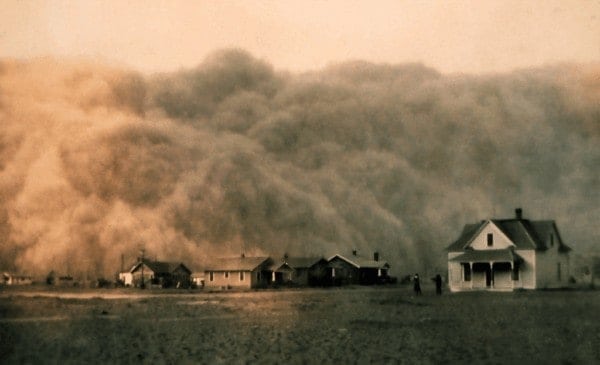There were many causes of the Great Depression. No economic disaster of that magnitude ever has a single cause. It is very hard to imagine the devastation caused by the economic downfall of the 1930s, because we haven’t really seen anything like it since then. Even with hard recessions, nothing has come close to the terrible situation the United States (and most of the world thereafter) found itself in during those times.
It has been argued that one of the reasons why the Great Depression was so bad was that the United States just got too big too fast. The vast expansion it experienced throughout its first hundred years after independence caused the burden on the lands that they took over to be unbearable.
Add in the burden of a devastating World War, which the US took part in between 1917 and 1919, and the burden on the land caused serious problems. The need for wheat during the World War overtaxed the land beyond its capabilities, and overgrown and overgrazed land eventually became barren and unsuitable to any type of growing. This compounded both the need for food in later years, and the eventual disaster that was the Great Depression.

During the years of 1934 through 1937, those states that had spent years growing wheat and corn on their land experienced one of the worst droughts ever to hit the United States. With the way the land had been overtaxed, there was no growth of any kind to anchor the soil, so when wind storms blew over the Great Plains, it kicked up astonishing amounts of dust.
This drought and the almost constant dust storms, gave the Mid-West the name “Dust Bowl.”
The impact of these storms was not only on the land and peoples of the Great Plains. On May 11, 1934, a major storm blew dust all the way to the East Coast, affecting cities like Buffalo, Boston, New York City, and Washington City. When the storm blew through Chicago two days earlier, it deposited an estimated 12 million pounds of silt and dust on the city.
These storms that affected vast portions of the United States would occur regularly until 1937. It wouldn’t only happen during the summer months, either. It would affect the winter as well, causing “Red Snow” to fall in places from the Great Plains to Maine.

One of the worst storms occurred on April 14, 1935. It swept all the way from Texas to Canada, and caused extensive damage. Several witnesses claimed that they couldn’t see more than five feet in front of them. An Associated Press reporter wrote this regarding what would come to be known as Black Sunday:
“Spearman and Hansford County (Kansas) have been literaly [sic] in a cloud of dust for the past week. Ever since Friday of last week, there hasn’t been a day pass but what the county was besieged with a blast of wind and dirt. On rare occasions when the wind did subside for a period of hours, the air has been so filled with dust that the town appeared to be overhung by a fog cloud.”
The aftermath of these years of drought and dust storms was something that took decades to recover from. It took years to replant the native prairie grass in the Great Plains, and even longer before crops could be planted once more.
The Dust Bowl years were hard for people who lived in the Plains States. As many as 500,000 Americans were left homeless, many of them taking the trip to California in hope of work. With the savage years of the Great Depression in full force, many of them were left without work for years.

